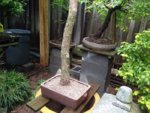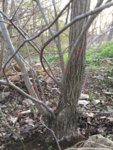You are using an out of date browser. It may not display this or other websites correctly.
You should upgrade or use an alternative browser.
You should upgrade or use an alternative browser.
Collected twin trunk cedar elm
- Thread starter Big Country Bonsai
- Start date
Big Country Bonsai
Shohin
J...How big is that new tree at the base if I can ask? I like the bark.
Not sure, I’ll have to take a tape measure next time. Bigger than the first one which is about 4 inches I’m diameter so probably around 6
atlarsenal
Omono
atlarsenal
Omono
Maybe chop the main trunk lower but I can’t really tell what’s going on in the back.
rockm
Spuds Moyogi
Pretty nice base. I would watch the buds on branches beginning at the end of this month and/or the weather forecast. They should begin swelling beginning around Feb. and continue through about April. Should be dug just before buds open. That trunk looks to be a beast and will require some elbow grease and a sharp saw to get it out. Same procedure as the smaller tree, only use heavier equipment. Bare root is best--move directly to container with bonsai soil.This tree is in the same grove as the one above. This one probably has more potential so I don’t want to mess it up when I collect. Wait till I start to see bud formation then collect and pot? Also where about do you guys think I should chop to during collection
I've dug trees this size and it's a lot of work. Best if you have a buddy to help shove it to one side to get underneath. Pics below show area and resulting tree. unfortunately, I was forced to dig the tree in late May/early June waaay out of season. As such, it had some issues pulling through. It ultimately died. BTW, the tree behind the potted trunk in the drum container is a CE I've had for 20 years.


rockm
Spuds Moyogi
Also note I reduced the trunk, but left it a bit long at collection. Trying to reduce the trunk on a collected tree to its "final" height when you collect it is a big mistake. Making such a "final" cut reduces your options for it. Better to leave it a bit long, see where bids pop and allow them to grow out for a season or two, THEN select one of those new shoots to use as the new apex.
rockm
Spuds Moyogi
Hardy Zone 6-9. I have a few here in Zone 7 Va. They do fine, but have to have winter protection in pots or they have some issues.Can someone tell me what zone these trees are good for? Thanks
They're mostly native to South and East Texas, up into Arkansas and over into Northern La. There is also, apparently a small isolated population in N. Fla., I think
https://www.srs.fs.usda.gov/pubs/misc/ag_654/volume_2/ulmus/crassifolia.htm
http://hort.ufl.edu/trees/ULMCRAA.pdf
Leo in N E Illinois
The Professor
- Messages
- 11,566
- Reaction score
- 24,102
- USDA Zone
- 5b
Elms for USDA zone 5 and zone 4 - these species should be able to be wintered, outdoors, without temperature protection, pot set on ground, protected from wind & maybe sun, mulching in optional.
Ulmus americana - American elm, in the landscape susceptible to Dutch elm disease, in a pot treatment is relatively easy. Leaves will reduce dramatically, almost as much as Chinese elm. Native to most of North America.
Ulmus thomasii - rock elm, also known as cedar elm, but it is not the same species called cedar elm in the southern USA. Native to northern Midwest America, into Canada.
Ulmus parvifolia var coreana - the Korean ecotype of the Chinese elm. Chinese elm from southern China may, or may not be winter hardy in zone 5, the Korean ecotype has survived through -29 F (-34 C) in trials at the Morton Arboretum in the west suburbs of Chicago. The Chinese elms I have tried, of unknown origin did not do particularly well. Worth experimenting with different sources.
Ulmus pumila - the Siberian elm - superior winter hardiness, an invasive species, to keep lower branches from weakening and dropping off, absolutely must have full sun pretty much from sunrise to sunset. If given enough sun, it works well for bonsai.
Ulmus glabra - the wych elm - this is the most northern, cold tolerant of the European elms - there is a tree or two surviving in Greenland. If you can find it, it can work in zone 4.
Ulmus rubra - native to the northern midwest NA into Canada, the Slippery elm, or red elm - looks like an American elm except "chiefly distinguished from American elm by its downy twigs, chestnut brown or reddish hairy buds, and slimy red inner bark" - flowers in spring before leaves appear, and flowers are reddish. This elm is a little bit more shade tolerant than some other elms. Still, full sun is usually best for cultivation.
Ulmus minor - the Field Elm - a widespread European elm that is very cold hardy. Possibly invasive in some areas of USA.
So the above are either native to the USA or somewhat available in commerce. The few below you are very unlikely to encounter, they might be hardy.
Rare in North America elms that might work - Ulmus davidiana, Ulmus glaucescens, Ulmus macrocarpa, Ulmus bergmanniana, Ulmus lamellosa,
This list is only a complete as the information from Wikipedia. There might be some trees I omitted. Apparently someone from the elm evaluation and breeding program at Morton Arboretum, in the western suburbs of Chicago had edited in some good information into Wikipedia.
Ulmus americana - American elm, in the landscape susceptible to Dutch elm disease, in a pot treatment is relatively easy. Leaves will reduce dramatically, almost as much as Chinese elm. Native to most of North America.
Ulmus thomasii - rock elm, also known as cedar elm, but it is not the same species called cedar elm in the southern USA. Native to northern Midwest America, into Canada.
Ulmus parvifolia var coreana - the Korean ecotype of the Chinese elm. Chinese elm from southern China may, or may not be winter hardy in zone 5, the Korean ecotype has survived through -29 F (-34 C) in trials at the Morton Arboretum in the west suburbs of Chicago. The Chinese elms I have tried, of unknown origin did not do particularly well. Worth experimenting with different sources.
Ulmus pumila - the Siberian elm - superior winter hardiness, an invasive species, to keep lower branches from weakening and dropping off, absolutely must have full sun pretty much from sunrise to sunset. If given enough sun, it works well for bonsai.
Ulmus glabra - the wych elm - this is the most northern, cold tolerant of the European elms - there is a tree or two surviving in Greenland. If you can find it, it can work in zone 4.
Ulmus rubra - native to the northern midwest NA into Canada, the Slippery elm, or red elm - looks like an American elm except "chiefly distinguished from American elm by its downy twigs, chestnut brown or reddish hairy buds, and slimy red inner bark" - flowers in spring before leaves appear, and flowers are reddish. This elm is a little bit more shade tolerant than some other elms. Still, full sun is usually best for cultivation.
Ulmus minor - the Field Elm - a widespread European elm that is very cold hardy. Possibly invasive in some areas of USA.
So the above are either native to the USA or somewhat available in commerce. The few below you are very unlikely to encounter, they might be hardy.
Rare in North America elms that might work - Ulmus davidiana, Ulmus glaucescens, Ulmus macrocarpa, Ulmus bergmanniana, Ulmus lamellosa,
This list is only a complete as the information from Wikipedia. There might be some trees I omitted. Apparently someone from the elm evaluation and breeding program at Morton Arboretum, in the western suburbs of Chicago had edited in some good information into Wikipedia.
Leo in N E Illinois
The Professor
- Messages
- 11,566
- Reaction score
- 24,102
- USDA Zone
- 5b
Rough bark
Siberian elm, Ulmus pumila - develops a fairly rough bark at an early age. maybe as little as 5 years.
American elm - has very distinguished rough alligator checked bark pattern, becomes deeply fissured, but it takes 40 years to get the ''good bark'', some bark starts at 10 years, but nothing special until long after I will be dead.
Ulmus rubra and Ulmus thomasii will both develop rough bark, bark more like the southern cedar elms. I believe around 10 years or so you should see some. Maybe sooner, maybe later. Fully developed bark at about 20 years.
Chinese elm - will always have a smooth bark that exfoliates in plates. They call that pattern ''lace bark''. It never gets very rough. The cultivars 'corticosa', 'yatsubusa', 'hokkaido' and 'Sejiu' all develop a thick corky bark. I believe 'Sejiu' develops bark the quickest, maybe start at 5 years, the others take longer. Most will not bark up the trunk from ground to branches until 15 to 20 years old. Could happen quicker, could be slower. 'Hokkaido' also has corky bark, it is a super-dwarf, and I find it a pain in the ass to grow. It is very brittle, breaks easy and is so small it is easy to misplace it in your collection. Probably grows less than 1 inch per year, which means doing anything takes forever.
The other elms I don't know that well.
Siberian elm, Ulmus pumila - develops a fairly rough bark at an early age. maybe as little as 5 years.
American elm - has very distinguished rough alligator checked bark pattern, becomes deeply fissured, but it takes 40 years to get the ''good bark'', some bark starts at 10 years, but nothing special until long after I will be dead.
Ulmus rubra and Ulmus thomasii will both develop rough bark, bark more like the southern cedar elms. I believe around 10 years or so you should see some. Maybe sooner, maybe later. Fully developed bark at about 20 years.
Chinese elm - will always have a smooth bark that exfoliates in plates. They call that pattern ''lace bark''. It never gets very rough. The cultivars 'corticosa', 'yatsubusa', 'hokkaido' and 'Sejiu' all develop a thick corky bark. I believe 'Sejiu' develops bark the quickest, maybe start at 5 years, the others take longer. Most will not bark up the trunk from ground to branches until 15 to 20 years old. Could happen quicker, could be slower. 'Hokkaido' also has corky bark, it is a super-dwarf, and I find it a pain in the ass to grow. It is very brittle, breaks easy and is so small it is easy to misplace it in your collection. Probably grows less than 1 inch per year, which means doing anything takes forever.
The other elms I don't know that well.
Big Country Bonsai
Shohin
Never went back to collect the second one (maybe it’ll happen this spring) but the first one has survived and is probably my most vigorous tree at the moment. I’m kind of overwhelmed with how many buds broke out but I guess that’s not a bad problem to have.
Attachments
Big Country Bonsai
Shohin
Similar threads
- Replies
- 18
- Views
- 2K
- Replies
- 5
- Views
- 1K
- Replies
- 3
- Views
- 244







